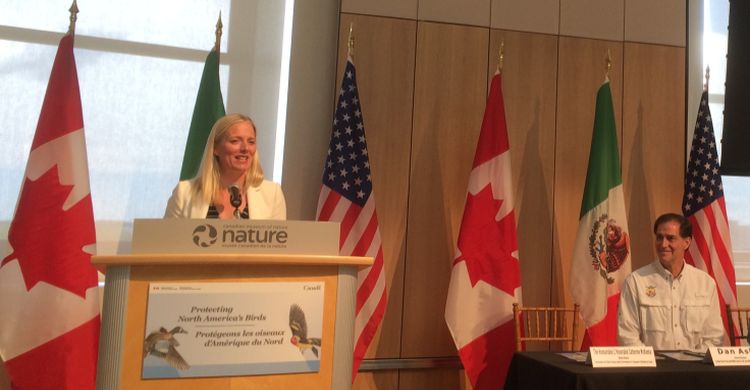XXI Meeting of the Canada/Mexico/U.S. Trilateral Committee for Wildlife and Ecosystem Conservation and Management

The Hon. Catherine McKenna, Environment Minister of Canada
Bonn, 24 May 2016 - The slogan of the XXI Meeting of the Trilateral Committee held in Ottawa, 16-19 May was “Celebrating 100 years of conservation of migratory birds and their habitats and looking ahead to the next 100 years”.
Collaboration in the field of bird conservation dates in North America back to the tragic conclusion of an environmental catastrophe. In 1914, what had been the most abundant bird species in North America, the Passenger Pigeon, went extinct with the death of Martha, the last lonely bird of her kind. In 1916, the Canadian, Charles Gordon Hewitt, drafted the Migratory Bird Convention to protect migratory birds from egg and nest collectors and unregulated hunting. In 1917 and 1918 respectively, Canada and the United States passed the Migratory Birds Convention Act and the Migratory Birds Treaty Act. In 1934, the US Congress passed the Duck Stamp Act to provide reliable funding sources for wildlife conservation leading to an increasing network of managed wetlands not only for wildfowl but for the whole biodiversity.
The first report on North America`s migratory birds was launched during the meeting, assessing the conservation status of 1,154 native species that occur in Canada, continental U.S. and Mexico (it is available in English and French). Great success has been achieved, notably through the North American Waterfowl Management Plan adopted in 1986 but the report’s watch list indicates that one third of North America’s bird species are of major conservation concern. The Hon. Catherine McKenna, Canadian Minister of Environment and Climate Change said “This report highlights the challenges and successes in bird conservation that we all face, and gives us tools that we can all continue to work together to protect nature`s resources for the benefit of people, birds and wildlife”.
In this context, during the plenary the Executive Secretary of AEWA, Jacques Trouvilliez, presented the African-Eurasian Migratory Waterbird Agreement as a model for conservation accross the continents. He showed that despite national and regional efforts, the conservation success is hampered if the flyway approach is not used as the basis for actions. As an intergovernmental treaty, AEWA is a tool for international cooperation for the flyway which encompasses the highest number of Range States - 119. As shown by the 6th Conservation Status Report delivered during the 6th Meeting of the Parties last year, conservation status is improving where concerted measures are taken all along the flyway, where key sites are protected and the exploitation of birds is well managed. Jacques Trouvilliez added “Working with non-Party Range States is also a key element of the success and helps build trust between countries, leading to further accessions.”
The Executive Secretary of CMS, Bradnee Chambers, had earlier provided the participants with a global overview of the structure and the actions of CMS, not only for migratory birds but for a wide range of species.
The participants of the Trilateral Committee have recommended for the next 100 years the adoption of a full-life cycle approach as more than 40 per cent of the Canadian bird species migrate to Central and Latin America. Canada, Mexico and the USA must continue to expand their shared efforts to include the other countries that are home to a common natural resource during any period of the annual migration cycle.
Last updated on 17 June 2016


